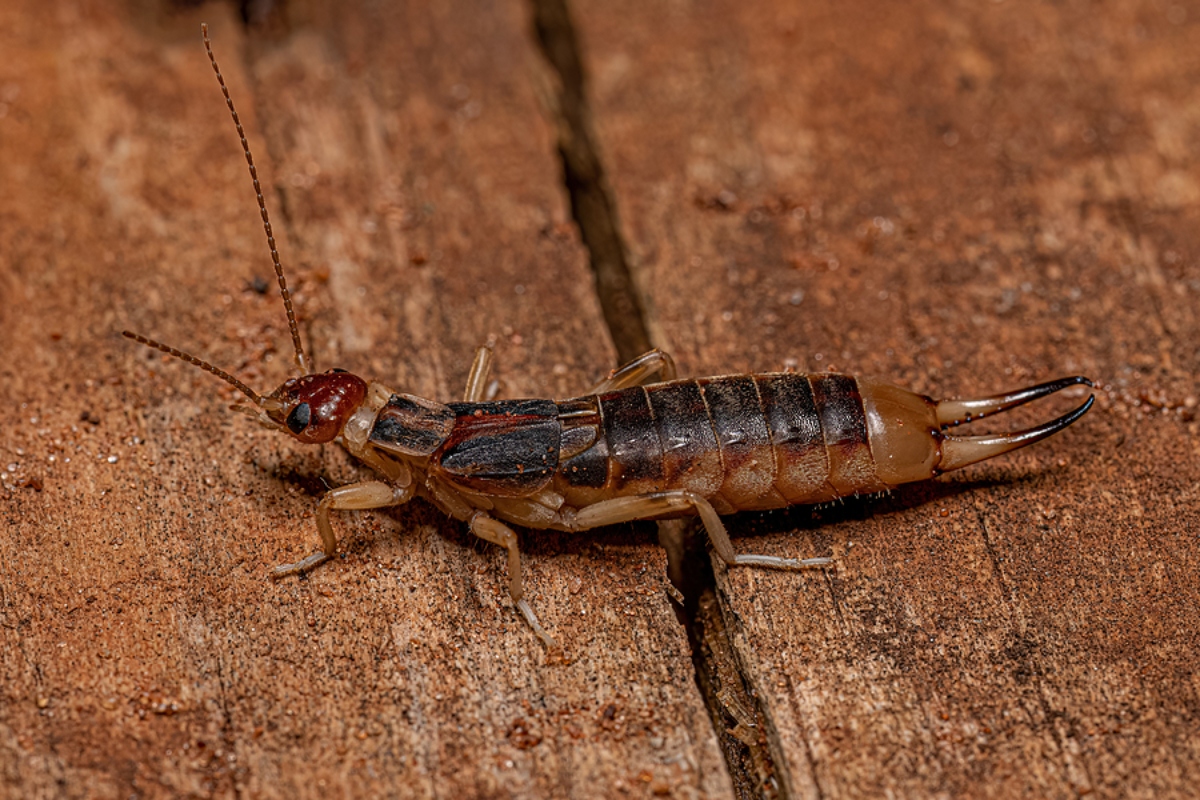The term “pincher bugs” commonly refers to insects like earwigs, known for their pincers or forceps-like structures at the end of their abdomen.
While they might seem intimidating due to their appearance, these insects typically aren’t harmful to humans and often play a beneficial role in consuming other pests like aphids or decomposing organic matter.
However, in some cases, they can become a nuisance indoors, prompting the need for preventive measures to keep them at bay.
Understanding Pincher Bugs (Earwigs)
Identification and Behavior
- Physical Features – Earwigs have elongated bodies, pincers at the end of their abdomen, and membranous wings folded underneath hard forewings.
- Habitats – They thrive in moist areas, such as gardens, mulch, or damp crevices around buildings.
Ways to Get Rid of Pincher Bugs
Outdoor Prevention
- Garden Maintenance – Clearing debris, mulch, and excessive moisture in gardens reduces favorable habitats for earwigs.
- Sealing Entry Points – Caulking gaps and cracks around doors, windows, and foundations prevent their entry into buildings.
Indoor Prevention
- Moisture Control – Fixing leaks and reducing excess moisture indoors discourages earwigs from seeking shelter.
- Regular Cleaning – Vacuuming and tidying up helps eliminate hiding spots, reducing their indoor presence.
Natural Deterrents and Traps
- Diatomaceous Earth – A natural substance that can be applied in areas where earwigs frequent, as it dehydrates and kills them.
- Traps – Placing rolled-up newspaper or cardboard tubes filled with straw or paper in infested areas can act as traps, which can be disposed of daily.
Creating Barriers
Physical Barriers: Implementing physical barriers like gravel or crushed rock around the foundation can deter earwigs from entering buildings.
Addressing Specific Scenarios
Garden and Plant Protection
- Mulch and Garden Beds – Using less moisture-retaining mulch or creating barriers between mulch and plant stems prevents earwigs from reaching plants.
- Natural Predators – Encouraging natural predators like birds or certain insects can help control earwig populations in gardens.
Indoor Nuisance
Addressing moisture issues and sealing entry points, especially in kitchens and bathrooms, helps prevent indoor infestations.
Challenges and Additional Considerations
- Pincher bugs might not necessitate extensive treatment unless they become a significant nuisance. Selective measures can be more practical.
- While they might occasionally enter homes, earwigs often contribute positively by consuming other pests and organic matter.
- Despite their appearance, earwigs do not crawl into human ears and are not aggressive towards humans.
- Emphasizing non-chemical control methods is eco-friendly and avoids potential harm to beneficial insects or pets.
FAQS
What are pincher bugs, and how can I prevent them from entering my home?
Pincher bugs, commonly known as earwigs, can be deterred by sealing entry points, reducing moisture indoors, and using natural deterrents like diatomaceous earth.
Do pincher bugs (earwigs) pose a threat to humans, and how can I control them in gardens?
Earwigs aren’t harmful to humans; controlling them in gardens involves reducing moisture, using less moisture-retaining mulch, and encouraging natural predators.
Are there natural methods to keep pincher bugs away from indoor spaces?
Yes, natural deterrents like diatomaceous earth and traps made of rolled-up newspaper or cardboard can help reduce earwig presence indoors.
Are Infestations of Pincher Bugs Common?
Because pincher bugs are not social insects like bees or carpenter ants, they would rather travel alone rather than live in a colony or nest. It is therefore uncommon for infestations to occur. Perfect circumstances are needed for household infestations, including high moisture content, easy access to vegetation, and lots of hiding spots.
When Do Pincher Bugs Appear?
The season for pincher bugs usually starts in late spring or early summer. They are usually at their busiest during this time, scuttling around gardens and damp ground in search of new growth. But as the chilly Winter months arrive, the insect’s numbers decline and those that survive move underground.
How do I identify and manage pincher bug infestations in damp areas like bathrooms?
Address moisture issues by fixing leaks, sealing entry points, and regularly cleaning damp areas to prevent earwigs from infesting bathrooms or kitchens.
What’s the best way to prevent pincher bugs from damaging plants in gardens?
Protect plants by creating barriers between mulch and stems, using gravel around the foundation, and encouraging natural predators to control earwigs in gardens.
Conclusion
Preventing pincher bugs infestations involves a combination of outdoor and indoor strategies tailored to reduce their favorable habitats and limit entry into buildings. Understanding their behavior and preferred environments enables the implementation of effective preventive measures.
While occasional intrusions might occur, maintaining cleanliness, managing moisture, and employing natural deterrents and barriers help mitigate the presence of earwigs indoors and in gardens. In most cases, their control requires minimal intervention, focusing more on creating less favorable conditions for their habitation


2 replies on “Eradicating Earwigs – Effective Strategies for Pincher Bugs Control”
[…] ants, like many pests including earwigs, bugs with pincers, and carpet bugs, are attracted to moisture. Address leaks and eliminate […]
[…] Regular Landscaping – Trim trees and shrubs regularly and keep the garden well-maintained to minimize hiding spots for pests. […]